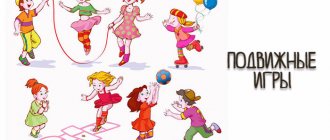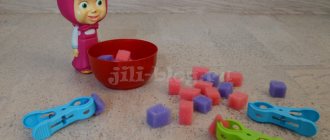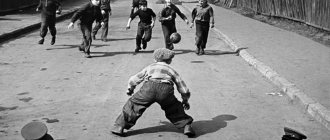Outdoor games 12
“Squirrels, nuts, cones.”
Everyone stands up, holding hands, three at a time, forming a “squirrel’s nest.” They agree among themselves who will be the “squirrel”, who will be the “nut”, and who will be the “bump”. The driver is alone, he does not have a nest. If the driver calls “squirrels,” then all the “squirrels” leave their nests and run to another. The driver must take the vacant seat. The one who does not have enough space becomes the driver. The same thing happens with the commands “nuts” and “cones”.
"Boogie - boogie."
Presenter: “We stretch our right hand forward and sing: “Put your right hand forward, and then back, and again forward and shake it a little. We dance "boogie-boogie", turn circles (at the same time we turn) and clap our hands like this (2 claps) ((everyone rushes forward to the center) boogie - boogie - ok (then back) boogie - boogie - oh' kay) (2 times).” Then follows: left leg, left hand, right leg, single nose, etc.
"Wolves in the Moat"
A corridor (“ditch”) up to one meter wide is drawn on the site. The ditch can be drawn in a zigzag shape, narrower in places and wider in others. The drivers – “wolves” (2 – 3 people) – are located in the ditch. The rest are “hares”. They must jump over the “ditch” and not get greasy. “Wolves” can grease only those “hares” that are located above the ditch, and if they succeed, then the greasy “hare” is eliminated from the game. "Hares" jumping over the ditch should not touch the line of the ditch. If they touch the line, they are out.
"Crows and Sparrows"
Two parallel lines are drawn at a distance of 1 meter. Another 4 - 5 meters are measured from them, and another line is drawn. The first two lines are the starting lines, the second are the “houses”. Teams line up with their backs to each other near the first lines. Each team is given a name - one is “crows”, the other is “sparrows”. If the presenter said “crows,” then the crows catch up with the sparrows, which are trying to escape to their “house.” All caught sparrows become crows. The same thing happens, only in reverse, if the presenter said “sparrows.”
"Blind Man's Bluff."
The game takes place on a small, limited area with no dangerous obstacles. The driver is blindfolded, or simply closes his eyes. He must make fun of one of the players with his eyes closed. The players run away from the driver, but do not go beyond the court. They must make a voice, calling the driver by name, or shouting: “I’m here.” The upset player changes places with the driver.
"Enchanted Castle"
Two teams play. The first team must disenchant the “castle”, and the second team must prevent them from doing this. The “castle” can be a tree or a wall. The team defending the “castle” must be blindfolded. They are located on the playground as they please. Two of them are located near the “castle” - the main gate. Players who need to disenchant the “lock”, at the command of the leader, begin to silently move towards the main gate. Their task is to go through the gate and touch the “lock”. The second team's task is to harass those who are moving towards the “castle”. Those who are insulted are eliminated from the game. Before the game, one condition must be specified: can the team move blindfolded or must they stand still.
"Defense of fortifications."
Participants of two teams form circles; a “town” of pins, balls, etc. is placed in the center of the circle. The driver from the opposing team stands near the “town”. The players' task is to destroy the "town" with the ball. The driver prevents this from happening by hitting the ball (you cannot step over the line when attacking).
"A hare without a lair."
The participants of the game stand in pairs facing each other, raising their clasped hands up. These are “houses” or “hare’s lairs”. Two drivers are selected - “hare” and “hunter”. The hare must run away from the hunter, while he can hide in the house, i.e. stand between the players. The one to whom his back is turned becomes a “hare” and runs away from the hunter. If the hunter hits the hare, they change places.
"Ivan da Marya".
Everyone stands in a circle, closing it. In the middle there is a girl and a boy. Both are blindfolded. Ivan must find Marya. They walk in circles. Ivan is looking for Marya, all the time asking: “Marya, where are you?” Marya should answer: “I’m here, Ivan,” while trying to change place as quickly as possible. After Ivan catches Marya, he chooses a new Marya from the children standing in a circle, and Marya chooses Ivan.
"From circle to circle."
Several circles are drawn. The players are in these circles. Between them there is a driver who does not have the right to enter the circles. You can't stay in a circle for a long time. The players must constantly run from one circle to another. The driver's task is to hit the player while he is not in the circle. The upset player becomes the driver.
"Traps."
Six players stand in pairs, holding both hands and raising them up. These are traps. They are located at a small distance from each other. All other players join hands, forming a chain. They must move through traps. When the leader claps, the traps “slam shut,” i.e., the traps’ arms are lowered. Those who are caught form pairs and become traps.
"Cat and Mice"
At a distance of 10 meters, 2 lines are drawn: behind one is a “cat” house, behind the other is a “mice” house. The “cat” is sleeping in his house, and the “mice” go to him with the words:
The mice came out one day See what time it was One, two, three, four The mice pulled the weights Suddenly there was a terrible ringing The mice ran out
All this time, the “mice” come up to the “cat” and can even touch him, but after the word “out” the cat wakes up and runs to catch up with the mice. The mice must hide in their house. Those who are caught by the cat are eliminated from the game or change roles with the cat.
"Cat - mouse - labyrinth."
All players stand in several rows behind each other. They join hands with neighbors standing next to them on the left and right, forming the “walls” of the labyrinth. “Cat” and “mouse” are selected. The task of the “cat” is to catch the “mouse”, and for the mouse to run away from it. They must run between these “walls”; At the same time, you cannot catch and run away through them. When the leader claps (whistles), all players lower their hands and turn clockwise 90 degrees and join hands again, thus changing the maze. The game continues until the “cat” catches the “mouse”. Throughout the game, the presenter can clap his hands at his discretion, changing the maze.
"Paints".
The driver is selected - the “monk” and the leader - the “seller”. All the other players secretly wish for colors from the “monk” that should not be repeated. The game begins with the driver coming to the “shop” and saying: “I, a monk in blue pants, have come to you for some paint.” Seller: “For what?” Monk: (names the color, for example “for blue”). If there is no such paint, then the seller says: “Walk along the blue path, you will find blue boots, wear them, and bring them back!” “The monk starts the game over.
If there is such a paint, then the player who has wished for this color tries to run away from the “monk”, and the “monk” catches up with him. If you catch up, then the driver becomes the painter, if not, then the colors are guessed again and the game continues.
"Red, yellow, green."
Players draw sealed tokens of three different colors. The team, united by one color, is given the task of catching up and eliminating the tokens from the enemy team, while maintaining its composition. A group with red tokens catches up with a group of yellow ones, yellow ones catch up with green ones, and green ones catch up with red ones. Each group has approximately the same number of players. The presenter announces the meeting place of each color group and gives a sound signal (whistle) to start the game. The presenter himself is in the center of the site, and players who have lost tokens gather near him.
"The Fox and the Gingerbread Man."
The players form a circle and kneel or squat. One person - the “fox” - stands in a circle. The circles in the chain begin to roll the ball - the “bun”, but so that the “fox” does not catch it. If the “bun” is caught, then the “fox” becomes the one who pushed the ball into its “paws”.
"Flashing lights."
The players sit in a circle, one chair is empty. There is a person behind each chair. The presenter (his chair is empty) blinks at those sitting, unnoticed by those standing. The one to whom he blinked must run to an empty chair, but those standing behind the chairs try to prevent this from happening. Those sitting and standing can change places.
Option for playing without chairs: Players in the inner circle do not sit, but stand. The players in the outer circle look at their partner's heels, holding their hands behind their backs. The presenter also flashes to someone in the inner circle. If they managed to catch him, the pair switch places. If the player standing in the outer circle did not succeed, then he becomes the leader, and the player who managed to run across becomes the player in the outer circle.
"Ball in a circle."
A circle is drawn. The driver kicks the ball, trying to knock it out of the circle. The players hold the ball with their feet and do not allow it to fly out of the circle. They can pass the detained ball to each other. If the driver manages to knock the ball out of the circle, then the player who missed the ball on his right side receives a penalty point. Therefore, each player tries to protect the gap between himself and his neighbor to the right. In this regard, the player moves somewhat in a circle. Explanation to the driver: you cannot lift the ball above the fields, this is punishable by a penalty point. The winner is the team that did not concede the ball longer, or scored fewer penalty points.
"Ball in a circle."
The players, forming a circle, sit down. The driver stands behind a circle with an inflatable ball. At the signal, the driver throws the ball to one of the players sitting in a circle, and he moves away. At this time, the ball begins to be thrown in a circle from one player to another. The driver runs after the ball and tries to intercept it on the fly. The player from whom the ball was caught becomes the driver. Players are prohibited from rising from their seats.
“Don’t give the ball to the driver.”
All players, except 2-3 drivers, stand in a circle and begin to throw the ball among themselves. The task of the drivers, who are in a circle, is to touch the ball with their hand, which the players throw among themselves. The driver who touched the ball with his hand is replaced by the player who failed to pass the ball to his partner. The game can be made more difficult by introducing a 3-second rule. During this time, the player must throw the ball to his partner.
"Seine".
The game takes place on a limited area, the boundaries of which cannot be crossed by any of the players. Two or three players join hands, forming a “net”. Their task is to catch the “fish” - the remaining players. If the “fish” could not evade, then it joins the drivers, increasing the “net”. The game continues until the last player remains - the winner.
"Guard the captain."
The game is played on a volleyball court. The players are divided into two teams, each of which has 1 captain, 3-5 forwards and the same number of defenders. Captains and defenders remain in their own half of the field, and forwards go to the opponent’s half of the court. After playing the ball from the center of the field, the team that has taken possession of the ball tries, by passing the ball, to get closer to the opposing captain and shower him with the ball. This is countered by defenders who try to intercept the ball and, in turn, send it into the opponent's half of the field to their attackers. For hitting the captain with the ball (he moves only in his own half of the court), the team receives 1 point. The rules do not allow defenders to cross to the opponent's side, or attackers to return to their own half to help the defenders. For violation of the rules, teams are punished by losing the ball. The game lasts 15-20 minutes. The team with the most points wins.
"Drag".
Variants of tug of war, instead of the classic tug of war
Content
1 Drag around the circle 2 Tug with sticks 3 Drag over the line 4 Turnip
Drag circle
A straight line is drawn through the middle of a circle with a diameter of 4 m, dividing it into two equal parts. Two players stand on both sides of the line with their backs to each other. A ring of rope with a diameter of 1.5 - 2 m is put on them so that it passes under the hands. While squatting, participants move their body forward so that the rope is slightly stretched. At the signal, both players begin to pull each other out of the circle. Whoever pulled who out of the circle won.
Drag on sticks
The players, divided into two teams, sit on the floor in single file: one group (team) against the other. The front ones grab the stick with both hands and rest their feet against each other. The rest of each team holds each other tightly by the waist. The tug-of-war begins on command. The team that wins is the one that wins over its opponents and snatches the stick from its opponents. The game can be played in pairs.
Drag the line
A line is drawn. Two teams stand opposite each other. At the signal, the players grab each other’s hands and try to drag each other over the line to their side. A player who crosses the line with both feet is considered a prisoner and is out of the game.
turnip
The players sit on the floor in single file, holding each other by the waist. The one in front is chosen to be the strongest and strongest (turnip). The turnip is taken onto something reinforced (post, tree, etc.). The rest (2,3,4) try with their combined strength to tear it off. The winner is the strong man who did not give in, or the group that tore him off. The game starts at the signal. The number of participants is determined in advance.
"Trains"
Each player has a depot - a small circle drawn. In the middle of the site there is a driver - a steam locomotive that does not have its own “depot”. The leader walks from one carriage to another. Whoever he approaches follows him. This is how the carriages are assembled. The locomotive suddenly whistles, and everyone runs to the depot, including the locomotive. The player left without a seat becomes the driver - the locomotive.
"Catch the dragon's tail."
Several teams line up in a column. Everyone holds the person in front by the belt. This is "dragon". The first in the column is the dragon's head, the last is the tail. The task of the head is to catch the tail of another dragon. The dragon's body should not be torn apart. Game option: just one dragon, the head catches its own tail.
"Scouts and sentry."
Flags are placed around the sentry. The flag can be a branch 60 centimeters long on which a scarf hangs. The number of flags is from 5 to 7. They are placed at a distance of 15 - 20 steps. The scouts move away to such a distance that the sentry cannot see them. Their task is to sneak up on the flag unnoticed and steal it. The sentry has the right to move around the area limited by the flags, but no further. If the sentry sees the scout and calls him by name, then the scout is eliminated from the game, and if the sentry notices the scout running away with the flag and calls him by name, then the flag returns to its place, and the scout can continue the game. A scout has no right to disguise himself or change clothes. The game ends when all scouts have dropped out of the game, or the sentry has one flag left. As a rule, not a single sentry misses the last flag.
"Traffic light".
Two lines are drawn on the site at a distance of 5 - 6 meters from each other. The players stand behind one line. The driver stands between the line approximately in the middle with his back to the players. The driver names a color. If the players have this color in their clothes, they freely pass by the driver to the other line. If there is no such color in clothes, then the driver can insult the player running across the space between the lines. The upset player becomes the driver.
"Jump-jump."
On a sports field or limited space, small circles with a diameter of 30-40 cm are drawn for each participant in the game. The driver stands in the center of the site. The driver says: “Jump!” After this word, the players quickly change places (in circles), jumping on one leg. The driver tries to take the place of one of the players, also jumping on one leg. The one who is left without a place becomes the driver.
Rules: You cannot push each other out of the circles. Two players cannot be in the same circle. When changing places, the circle is considered to belong to the one who joined it earlier.
"Elephant".
This game involves two teams of boys of 6-8 people. One of the teams must line up in a column. Each player bends down, presses his head to the belt of the one in front, while holding onto him with his hands. This team is the “elephant”. The second team must “climb the elephant. It's done like this. The first player stands on the side of the “elephant’s tail”, runs up and, pushing off against the back of the last player – the “elephant”, makes the largest possible jump onto the “elephant’s back”. He must “land” so as not to fall from his back and not touch the ground with his feet. Then all other players from the “riders” team make jumps. If one of them could not resist and fell from the “elephant”, then the game ends and the teams change places. After everyone has jumped in, the “elephant” must walk 8–10 meters, after which the teams change places.
"Stop."
The players form a circle with the ball in the center. He throws the ball up, after which all players scatter in different directions. Having caught the ball, the driver orders: “Stop!”, and all players stop. From the place where he caught the ball, the driver tries to hit some player with the ball. If he succeeds, the eliminated player becomes the driver. If not, then he is still driving
"Shooter."
The players are divided into two teams and are located behind the lines on opposite sides. Two parallel lines are drawn on the site at a distance of 10-15 m from each other. Between the lines, a circle with a diameter of 2 m is drawn in the center, in which the shooter with the ball is located. At the leader’s whistle, the teams take turns changing places, running to the opposite line. The shooter tries to hit the player. Rules: the moment of the throw is determined by the shooter himself. A ball thrown wide is returned to the shooter. If a player catches a ball thrown at him, this is not considered a hit. One hit on a player means a penalty point for the team. The team with the fewest penalty points wins.
Game option: after being hit by the ball, the player is eliminated. The team with the remaining players wins. The game can be played for a while.
"You're going slower."
The driver and the players are on opposite sides of two lines, which are drawn at a distance of 5 - 6 meters from each other. The players’ task is to reach the driver as quickly as possible and touch him with their hand. The one who did this becomes the driver. The players move only in response to the words of the driver: “If you drive more quietly, you will continue!” Stop!". At the word “stop” all the players freeze. The driver, who previously stood with his back to the players, turns and looks. If at this moment one of the players moves, and the driver notices this, then this player will have to go back beyond the line. The driver can make the frozen guys laugh. Whoever laughs also comes back. Game continues.
"Third wheel".
The players stand in pairs facing the center, forming two circles. Two drivers - one runs away, the other catches up. They run around in circles, but can only walk through the circle on one leg. The running player can stand in front of any pair. The one who was third (last) becomes the runner, and now the second player catches up with him
"Tutti Frutti".
The team is divided into two or more fronts and chooses a name for itself - fruit. One person stands in the center and tells a story. As soon as he uses one of the fruit names, the members of that front must switch places with each other. If it is pronounced “tutti - frutti”, then all members of all fronts must change places.
"By the Bear in the Forest".
Two lines are drawn on the site at a distance of 6 - 8 meters from each other. Behind one line is the driver - the “bear”, and behind the other is the house in which the children live. Children go out of the “house” into the “forest” to pick mushrooms and berries. They approach the bear's den with the words:
I take mushrooms and berries from the bear in the forest, but the bear does not sleep, everything looks at us.
At the last words, the “bear” jumps out of the “den” and tries to grease the children running away to their house. The upset player becomes a “bear”.
"Fishing rod".
A fishing rod is a jump rope. One end of it is in the hand of the “fisherman” - the driver. All players stand around the “fisherman” no further than the length of the rope. The “fisherman” spins the “fishing rod”, trying to hit the legs of the players with it. The “fish” must protect themselves from the fishing rod by jumping over it. They should not interfere with each other, and also not leave their places. If the “fisherman” managed to catch the “fish”, that is, touch the “fishing rod”, then the place of the “fisherman” is taken by the caught “fish”. The following condition must be observed: the rope cannot be raised higher than 10–20 centimeters.
"Chains-forged."
Two teams play. They stand holding hands, facing each other, at a distance of 5 - 7 meters. One of the teams begins the game with the words: “The chains are forged, unchain us.” The second team answers in unison: “Which of us?” The first team calls the name of one of the players on the opposing team. The named player leaves his team and runs to the enemy team with the goal of breaking the chain, i.e., uncoupling the players’ hands. If he succeeds, he takes the player who unclasped his hands to his team. If the chain is not broken, then he remains on the opposing team. The teams start the game one by one. The team that has the most players after a certain time wins.
“Cheers, by the tree.”
They play in open areas where there are trees. Everyone except the driver stands near the trees, the driver stands in the middle between the trees. Those standing by the tree begin to run from tree to tree. The driver must smack them before the runner runs up to the tree and says: “Come on, by the tree!” The one who is salted becomes the driver, and the driver takes the place of the player playing by the tree.
Synchronized pair
The guys are divided into pairs, among which they will choose the most synchronous one. And to find out which of the participants can work best in a team, couples go through 3 stages of testing. Stage one: the leader moves the rope in a circle, and the couples jump up, always holding hands. Whoever does this most synchronously gets a point. Stage two: holding hands, each pair, at the command “start”, begins to squat 10 times. Whoever is most in sync gets a point. Stage three: the guys receive a ball and, holding hands with their free hands, hit it off the floor 10 times. Whoever is more synchronized gets a point. In this competition there will be either one winning couple or several. The winners receive the title of the most synchronous participants in the event and prizes.
Construction of houses
Needless to say, how much children love to build things? And it doesn’t matter at all whether it’s an expensive construction set, wooden blocks left over after renovation, shoe boxes or an umbrella and a blanket - the process is always fascinating.
Although, as practice shows, unnecessary boxes or a covered chair usually win in popularity.
- A selection of hotels for family holidays
Constructors
In any home there will be small Lego pieces or a box with wooden towers, arches and blocks of different sizes.
For a bored child, offer to build a home for your favorite toy: a little man, a doll, a bear, etc. You can not limit yourself to just walls, but build simple furniture and celebrate the move.
Suitable for age: 5-8 years old.
Carton boxes
It happens that shoe boxes have accumulated or large packaging from household appliances has appeared. Then a house can be built for dolls (for boys - a garage or parking lot) or for a baby.
Such structures can be pasted over, painted, filled with furniture - in general, playing with them will captivate young architects and designers for more than one day.
Suitable for age: 6-10 years old.
Armchairs, blankets and umbrellas
The good old “housing” option, inexplicably of interest to all generations of children without exception. A blanket or blanket can be placed on the table, secured with books, it can be used to cover two chairs, or something similar can be built using a regular umbrella.
Fantasy begins to manifest itself instantly, and sofa pillows, blankets and other improvised means are used. True, after such a game you will have to spend some time cleaning.
Suitable for age: 4-8 years old.
Rivals
The guys are divided into pairs and in each pair the participants have their legs tied: one has the left leg, and the other has the right leg. Objects, for example, chips, matches, cards, are scattered at the same distance from each participant. At the “start” command, the guys from the pair begin to collect objects, pulling each other to their side. Whichever participant in a pair collects more items in 1 minute advances to the next stage - the stage of competition with the winner from the other pair. And in the end, the strongest and most dexterous person will receive a prize.
Hive
The slogan of the game sounds like “Small war, deep strategy” is not accidental, because this board game has strategic depth and is aimed at capturing the queen of the opponent’s hive with the help of your insects: spiders, beetles, grasshoppers and ants. Each insect moves in a special way, just like in chess, so move the pieces and try to surround the “queen” - if this happens, celebrate your victory!
Age: 10+
Cashflow
A full-fledged life simulator, in which a teenager will learn financial literacy, learn how to make money from investments and manage their economic budget. By moving chips across the playing field, participants receive a salary, plan income and expenses, manage funds and slowly but surely move towards their dreams.
Age: 12+
Munchkin
This is an iconic parody of the classic fantasy role-playing game, which allows you to go down into the dungeon and play a lot of social roles, and the producers promise excitement, dynamics and schadenfreude. During the game, teenagers will learn the power of suspicious potions, fight monsters, learn martial arts, try on a couple of stylish outfits, and the one whose character can be the first to reach the sky-high tenth level by hook or by crook will win.
Age: 12+
Activity Original
It's simple: teams compete in guessing words from 440 game cards against the clock. If in “Alias” the explanation goes in one way, then there is a choice: you can explain it in other words, you can show it in pantomime, you can draw it. Time limits and the desire to win make this game active, intense and fun!
Age: 12+









